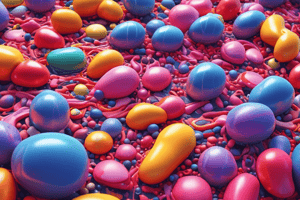Podcast
Questions and Answers
Qu'est-ce que la perméabilité sélective de la membrane cellulaire?
Qu'est-ce que la perméabilité sélective de la membrane cellulaire?
C'est la capacité de la membrane à laisser passer certains types de molécules tout en en bloquant d'autres.
Quel est le rôle principal de la modèle de la mosaïque fluide?
Quel est le rôle principal de la modèle de la mosaïque fluide?
Il décrit la structure et le comportement de la membrane plasmique.
Quel est le rôle des protéines de transport dans la perméabilité sélective?
Quel est le rôle des protéines de transport dans la perméabilité sélective?
Elles facilitent le transport sélectif de molécules à travers la membrane cellulaire.
Comment les protéines de canal diffèrent-elles des protéines de transporteur?
Comment les protéines de canal diffèrent-elles des protéines de transporteur?
Quel type de molécules peut facilement diffuser à travers la bicouche lipidique?
Quel type de molécules peut facilement diffuser à travers la bicouche lipidique?
Pourquoi les grosses molécules polaires comme le glucose nécessitent-elles des protéines de transport pour passer à travers la membrane?
Pourquoi les grosses molécules polaires comme le glucose nécessitent-elles des protéines de transport pour passer à travers la membrane?
Quelle est la principale fonction de la membrane cellulaire ?
Quelle est la principale fonction de la membrane cellulaire ?
Décrivez brièvement la structure de la membrane cellulaire.
Décrivez brièvement la structure de la membrane cellulaire.
Qu'est-ce que le modèle de la mosaïque fluide ?
Qu'est-ce que le modèle de la mosaïque fluide ?
Quelle est la différence entre les protéines intégrales et les protéines périphériques de la membrane ?
Quelle est la différence entre les protéines intégrales et les protéines périphériques de la membrane ?
Que signifie la perméabilité sélective de la membrane cellulaire ?
Que signifie la perméabilité sélective de la membrane cellulaire ?
Quel est le rôle des protéines de transport dans la membrane cellulaire ?
Quel est le rôle des protéines de transport dans la membrane cellulaire ?
Study Notes
Cell Membrane
The cell membrane, also known as the plasma membrane, is a thin layer that surrounds each cell and protects it from its external environment while controlling the movement of substances into and out of the cell. It is composed primarily of phospholipids, cholesterol, and proteins. The cell membrane is a dynamic structure that allows for selective permeability and the maintenance of a distinct internal environment for the cell. In this article, we will explore the structure, function, fluid mosaic model, transport proteins, and permeability of the cell membrane.
Structure
The cell membrane is organized into a bilayer, with the hydrophilic (water-loving) heads of the phospholipids facing outwards, while the hydrophobic (water-fearing) tails remain in the interior. This arrangement allows for the lipids to stay apart, maintaining the integrity of the membrane. The membrane is also home to various proteins, which play crucial roles in cellular processes such as communication and transport. Proteins in the cell membrane are either integral or peripheral, depending on their association with the membrane. Integral proteins span the membrane and are directly associated with the lipid bilayer, while peripheral proteins are indirectly associated with the membrane through protein-protein interactions.
Function
The main function of the cell membrane is to regulate the movement of substances between the cell's interior and exterior. It achieves this through its selective permeability, which allows for certain molecules to pass while blocking others. This property enables cells to maintain a distinct internal environment that is essential for their survival and proper functioning. The cell membrane also serves as a barrier against external threats such as pathogens and environmental toxins.
Fluid Mosaic Model
The fluid mosaic model, first proposed in 1972, describes the structure and behavior of the plasma membrane. This model states that the membrane consists of a dynamic mosaic of phospholipids and proteins that move freely in the plane of the membrane. In this model, both lipids and proteins are constantly moving, creating a fluidlike appearance similar to icebergs floating in the ocean. This fluidity ensures that the membrane can adapt to changes in temperature and other factors, allowing it to remain functional under various conditions.
Transport Proteins
Transport proteins play a vital role in the selective permeability of the cell membrane. These proteins can be divided into two general classes: channel proteins and carrier proteins. Channel proteins form open channels through the membrane, allowing the free passage of any molecule of the appropriate size. Ion channels, for example, facilitate the movement of inorganic ions like Na+, K+, Ca2+, and Cl- across the plasma membrane. Carrier proteins, on the other hand, selectively bind and transport small molecules such as glucose across the membrane without forming open channels. They act similarly to enzymes, facilitating the transport process by promoting conformational changes that create temporary channels for the passage of specific molecules. Both channel and carrier proteins are essential for maintaining the cell's internal environment.
Permeability
The fluidity and selective permeability of the cell membrane are determined by its composition and structure. Small uncharged molecules such as O2 and CO2 can easily diffuse through the phospholipid bilayer due to their nonpolar nature. However, large polar molecules like glucose cannot pass directly through the membrane and require transport proteins for passage. Charged molecules like ions are unable to diffuse across the lipid bilayer, while some small polar molecules may still be able to cross via specific transmembrane proteins. The plasma membrane maintains an equilibrium between allowing necessary substances into the cell while preventing harmful ones from entering.
Studying That Suits You
Use AI to generate personalized quizzes and flashcards to suit your learning preferences.
Description
Explore the structure, function, fluid mosaic model, transport proteins, and permeability of the cell membrane. Learn about the composition of the lipid bilayer, the roles of integral and peripheral proteins, and how transport proteins facilitate the movement of substances across the membrane.




